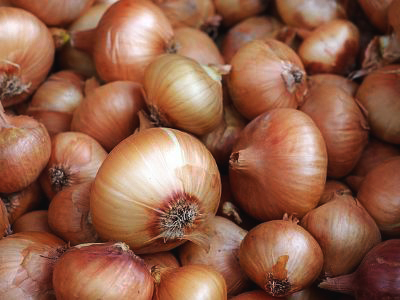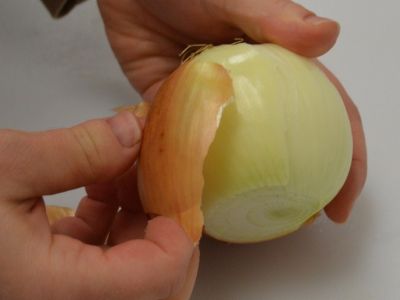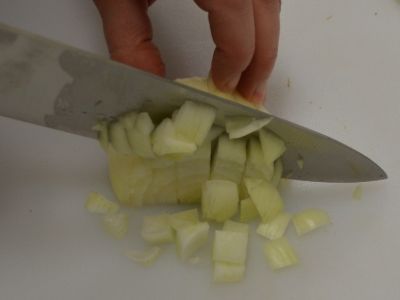Onions

Preparation: Step-by-Step

Wash hands. Thoroughly rinse onions to remove dirt or sand. To minimize irritation to skin and eyes, immerse a trimmed onion in cold water for a few minutes or chill onion for 30 minutes before chopping or slicing.

Cut off the stem end of the onion. Peel the outer layers of the onion skin. Cut the peeled onion in half from root end to stem end.

Lay each half cut-side down and make multiple, evenly-spaced cuts from root end to stem end. Do not cut through root end since it will hold the onion together. Then make horizontal cuts parallel to the cutting surface.

To dice, cut across the onion, adjusting the number of slices for desired dice size. Separate onion pieces.
Grow.
- Start with small bulbs less than ¾-inch in diameter. Plant 2-4 weeks prior to last
spring frost. Plant bulbs about one inch deep and 2-4 inches apart in full sun. Onions
have a shallow root system that needs consistent moisture and weed control. Water
with 1-2 inches of water per week.
For more growing information, look for the MSU Extension MontGuide: Planting a Successful Home Vegetable Garden, or contact your local MSU Extension office.
Harvest.
- Harvest onions when the tops have fallen over naturally and papery skins have formed. Remove tops and place in mesh bag in a cool, dark space for 2-3 weeks to dry.
- Onions should be firm and have little-to-no scent. Avoid bulbs with cuts, bruises, blemishes or mold. When purchasing whole, peeled onions, select ones with an outside layer that does not show signs of dehydration or mold.
- Onions will keep longer if not washed until just prior to preparation. Whole, dry bulb onions should be kept in a cool, dry, dark place with plenty of air movement. Do not store onions in a plastic bag. Refrigeration is only necessary when trying to extend the shelf life of sweet or mild onion varieties with high water content. Whole peeled or cut onions should be refrigerated after purchasing.
- Most vegetables are rich in fiber and phytochemicals, but provide negligible amounts of saturated fat, trans fat, cholesterol, and sodium and are gluten-free. Onions have only 32 calories per half-cup serving.
Caramelize.
- Heat pan on low, add oil to coat bottom of pan, add 1/4- to 1/2-inch thick slices of onion. Sweat onions in a covered pan until soft and translucent. Remove lid and increase heat to medium. Start stirring when onions begin to brown on bottom, then sauté until onions are soft and brown.
Grill.
- Peel and cut onions into slices or wedges. Cover grill with foil and poke small holes in foil. Pierce onions with a skewer, if desired and place over medium heat. Cover with a foil pan and grill for 15-20 minutes or until tender.
Raw.
- Add onions to salads, sandwiches, burgers, tacos, salsas and relishes
Sauté.
- Heat pan to medium, add oil to coat bottom of pan, add 1/4- to 1/2-inch thick slices of onion. Cook onions about 8-10 minutes or until brown.
Steam.
- Add sliced, quartered or large diced onions into steamer or pan of boiling water. Steam until tender.
Roast.
- Place sliced, quartered or small onions in a roasting pan. Drizzle lightly with oil. Roast with other vegetables or herbs and spices, if desired, for 20-30 minutes at 4000F. Roasted onions can be added to other dishes for additional flavor.
Preserve.
For more information on preserving vegetables, view these MSU Extension MontGuides: Freezing Vegetables and Drying Vegetables. Or contact your local MSU Extension office.
For More Information:
Montana State University Extension: msuextension.org
MSU Extension Master Gardener: mtmastergardener.org
MSU Extension Food and Nutrition: nutrition.msuextension.org
MSU Extension Nutrition Education Programs: buyeatlivebetter.org
Date of Publication: January 2014
